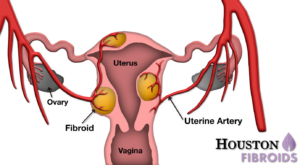If you're wondering, are all fibroids the same, this read's for you! All fibroids, (also called myomas or leiomyomas) are non-cancerous growths of muscular tissues. They all develop in and on a woman's uterus. Yet not all fibroids will develop in the same location, or cause the same symptoms. That's why we tend to classify fibroids based on where with the uterus they develop.

There are three different fibroid classifications. Intramural fibroids grow almost entirely within the wall of the uterus. Submucosal tumors grow from the uterine wall and push into the cavity of the uterus. Subserosal fibroids grow out of the uterine lining, poking through the uterine wall. Your symptoms may be different from another woman's depending on the type or location of your fibroids. But, for all women with fibroids, symptoms tend to fall in three main categories:
Bleeding
For all women, fibroids can cause long, heavy periods and/or bleeding even when it's not that time of the month. All fibroids affect blood flow to the uterus in some way, which is why your period typically gets heavier. Women with submucosal fibroids typically experience the heaviest periods, because they push your uterine lining into the cavity, greatly expanding its reach. Heavy bleeding is a symptom that should be addressed right away with your doctor, since, over time, it can make you anemic.
Pain
Mild discomfort or cramping is often a normal part of your menstrual cycle: the cramps are caused by slight changes to your uterus as you shed its lining. When you have fibroids, the changes to the uterus are more significant, which is why your cramps are likely to be stronger and more painful with these tumors. Women with intramural or subserosal fibroids may also experience lower back pain, as their enlarged uterus pushes against the muscles of the back. And women with fibroid tumors located near the cervical opening may experience pain during sex, although certain positions will be more comfortable than others.
Pressure
Women with fibroids often experience pressure or heaviness in the pelvis because the tumors increase the size of their uterus. Women with subserosal fibroids may become constipated or feel the need to urinate frequently, as their uterine lining expands and places pressure on either the bladder or the rectum.

When your uterine tumors get large, that can make your symptoms worse. It may also limit your treatment options, since larger growths could require more aggressive treatment. Or, if the growths get too large, you may experience something called fibroid degeneration.
What is this condition? Well, it's something that happens when your tumors are so large, they can't survive with existing blood supplies. As a result, they start to break apart and die.
Now, while this sounds like an easy solution to your condition, it actually isn't. Because, while your growths temporarily get smaller, they'll likely grow back again. Plus, while they degenerate, you may experience painful symptoms such as sharp pain and fevers.
These growths may degenerate at any time, but it's most common during pregnancy. One condition, known as red degeneration, almost exclusively affects pregnant women. It's called red degeneration because the fibroids appear red in color as they break apart. During pregnancy, this may lead to heavy bleeding, so your OB may need to carefully monitor your pregnancy.
When these growths degenerate, they may harden around the edges. (We call that calcification.) But in some cases, the entire tumor calcifies, making it resemble a hard lump instead of a muscular growth.
Once this happens, your other symptoms may get worse. Or, the hardened growth could block your vagina, causing a condition known as vaginal prolapse. Calcification often impacts women who have gone through menopause. But this shift could happen at any time after your diagnosis, possibly impacting your desire to seek treatment.
As you can see, the size and location of uterine growths can change the way you feel, or limit your treatment options. But, regardless of where your fibroids are located, and no matter which symptoms you find most bothersome, relief is available, often without surgery. Contact our Houston area fibroid specialists to learn if you are a candidate for our minimally-invasive fibroid treatment.
Sources: healthline.com, mayoclinic.org, verywellhealth.com

Scheduling
Please contact our dedicated specialists to schedule a consultation today.
2024 Houston Fibroids. All rights reserved. Website Design by Healthcare Success